For professional studio recordings or live mic’ing, XLR remains the way to go. Our venues and studios are set up around it – and for good reason. For all the microphone traditionalists out there, here are our best 11 XLR microphones.
XLR stands for External Line Return, and it comes in a distinctive 3-pin design that you’ll see on most audio devices.
So, what are the benefits of XLR microphones over USB? Well, there are a lot of reasons it’s the professional standard for audio. XLR is the only connector that has a balanced, noiseless transfer, for one. This is what really makes it the go-to, as you want the cleanest possible signal on stages and in studio recordings.
XLR also allows for phantom power connectivity for condenser microphones, transferring an additional 48 volts to power large-diaphragm condensers. This offers electrical protection to prevent damage from power surges, for example, and a secure latching system for locking cable connection that stays in place. The durability, reliability, and sound fidelity keep XLR the standard for audio.
In a hurry?
Here are our top 5 XLR mics to get you started:
| Shure SM58 | The ultimate live vocal microphone. | Check the current price |
| Rode NT1 5th Gen | Dual-connector USB and XLR condenser mic with 32-bit float recording, ideal for home studios. | Check the current price |
| SubZero VX01 | Full home recording pack with a FET condenser mic, USB audio interface, headphones and more. | Check the current price |
| Neumann TLM 102 | Affordable take on Neumann’s premium vocal mics with new transformerless design. | Check the current price |
| Universal Audio Sphere DLX | Unique dual-capsule modelling mic with 38 models and stereo recording capabilities via plugin. | Check the current price |
Best XLR Microphones
1. Shure SM58
The ultimate live vocal mic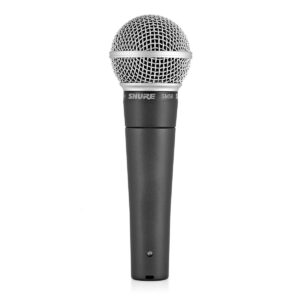
Specifications:
- Capsule: Condenser
- Polar Pattern: Cardioid
- Frequency Response: 50 Hz – 15 kHz
Pros and Cons:
- Incredible sound pressure handling for loud sounds without distortion
- Built for toughness and extensively tested for unparalleled reliability
- High-frequency roll-off can sacrifice some detail and treble
The Shure SM58 is a revolutionary vocal microphone in the world of live music, remaining a standard to this day. Its dynamic cardioid design is great at rejecting sources other than the voice placed in front of it, with a thick midrange and an upper-mid presence boost that lets any voice cut through a mix clearly.
The benefit of its dynamic capsule is its ability to not distort at high sound pressure levels, letting you perform with great volume or push a lot of gain into it without clipping. The SM58 and its predecessors in Shure’s Unidyne range throughout the late 1950s and early 1960s helped expand the size and volume of sound systems thanks to their incredible gain handling.
However, the SM58 is also great on instruments in the studio, partially due to its ubiquity and its sound. Its full midrange is great for capturing tom drums, snares, and other high-pressure percussion instruments, and it can even be used on guitar cabs and amps. That’s aside from the obvious vocal recording purposes!
With an affordable price and a near-bulletproof build quality, the SM58 is the choice for touring performers and those getting started with home studio recording.
2. Rode NT1 5th Gen
Dual USB and XLR condenser with 32-bit float recording
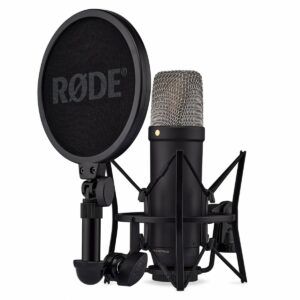 Specifications:
Specifications:
- Capsule: Condenser
- Polar Pattern: Cardioid
- Frequency Response: 20 Hz – 20 kHz
Pros and Cons:
- Unique dual-output XLR and USB-C microphone
- Built-in preamp and 32-bit float recording over USB output
- No 32-bit recording from XLR output
Australian manufacturer Rode developed a unique and innovative design in this 5th revision of their NT1. The original NT1 was built to capture the emerging home production market in 1997, delivering the sound of a large-diaphragm condenser that’s great on vocals, guitars, bass amps, snare drums, and overheads.
The versatility of the original remains in the 5th Generation model. But there have been some tweaks to its sound as well as a new and distinct feature that no other manufacturer has managed to achieve before.
The main thing of note is the NT1 5th Gen’s dual XLR and USB outputs which provide dual connectivity options and can be used to record simultaneously, for one. And the USB output can be used for 32-bit float recording, meaning that recordings that would clip over XLR can be recorded without distortion.
3. SubZero VX01
Ideal starter mic for vocalists and home recording
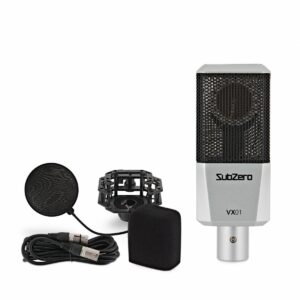 Specifications:
Specifications:
- Capsule: Condenser
- Polar Pattern: Cardioid
- Frequency Response: 20 Hz – 20 kHz
Pros and Cons:
- Detailed condenser microphone with versatility for home recording
- Complete with an accessory pack for instant recording setup
- No microphone stand or arm in the accessory pack
The SubZero VX01 is a modern FET condenser microphone with a transparent midrange, detailed treble, and warm low-end. Designed primarily for vocalists, the VX01 comes with a complete accessory pack, including a windshield, pop filter, shock mount, and XLR cable – everything you need to get recording instantly.
The VX01 is a great choice for streaming, video and voiceover, podcasting, and music production. It has an incredibly smooth and clear frequency response, projecting sound with articulation from the bass to the treble.
Whilst aimed squarely at vocalists, the VX01 would also do a great job of recording drum overheads, acoustic guitar, guitar amps and cabs, snare drums, and a wide range of other acoustic instruments or percussion.
4. Shure SM57
Versatile dynamic instrument mic
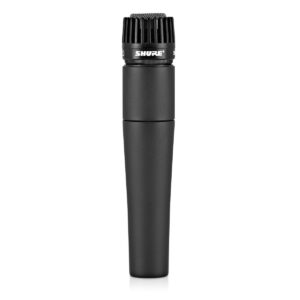 Specifications:
Specifications:
- Capsule: Dynamic
- Polar Pattern: Cardioid
- Frequency Response: 40 Hz – 15 kHz
Pros and Cons:
- A complete studio workhorse for all kinds of instrument recording
- Same reliable build quality and extensive testing as SM58
- Dynamic element doesn’t capture as much detail as condenser mics
The Shure SM57 is an extremely popular and versatile instrument microphone released in 1965, and it has been commonly used on guitar cabinets, snare drums, and all kinds of other sources, including all presidential speeches since Lyndon B. Johnson!
To give you an even better idea of the significance and popularity of this mic, it was also responsible for the guitar sound on Nirvana’s Nevermind, the snare drum on AC/DC’s Back in Black, and plenty more instruments and even vocals on familiar albums.
Owing to its versatility and durability, it’s common for professional recording studios to have a few SM57s in their mic locker. Not only that, but the SM57 is a commonly used live microphone too. You’ll see it on amps, snare drums, and even drum overheads. The SM57 has been used by David Gilmour, Slash, Josh Homme, Stevie Ray Vaughn, Johnny Marr, Brian May, Tony Iommi, and even Deadmau5.
5. Universal Audio Sphere DLX
Premium stereo modelling microphone
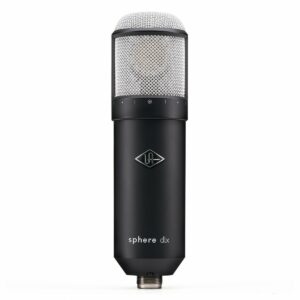 Specifications:
Specifications:
- Capsule: Dual Condenser
- Polar Pattern: Variable Dual Output
- Frequency Response: 20 Hz – 20 kHz
Pros and Cons:
- Modelling microphone offers models of 38 studio classic mics
- Dual element allows for stereo recording or two mono mic blends at once
- Reliance on plugin control limits use cases
The Sphere DLX is a pretty unique condenser microphone, mainly for the fact that it captures sound with absolutely zero character of its own. Instead, it comes with proprietary microphone modelling plugins that let you apply one of 38 microphone simulations whilst recording, but this can also be changed in the mix.
All of these microphone emulations model classic studio mics used throughout the decades-long history of audio recording, with a range of condenser, dynamic and ribbon microphones available. So, the Sphere DLX gives you an entire virtual studio mic locker for the price of a single mic.
Its reliance on plugin control makes the DLX firmly a studio microphone as it requires this plugin control to operate properly. Having said this, it also features room correction, stereo recording from its dual capsules, and adjustable polar patterns. This one’s perfect for exacting producers working on a wide range of different genres who need a single mic that can quite literally do it all.
6. Sennheiser e935
A detailed dynamic vocal mic with smoothness and detail
 Specifications:
Specifications:
- Capsule: Dynamic
- Polar Pattern: Cardioid
- Frequency Response: 40 Hz – 18 kHz
Pros and Cons:
- Dynamic vocal mic for live performance
- Extended treble and flat midrange for detailed, accurate sound
- Smoother presence boost may be harder to cut through the mix for heavier genres
The Sennheiser e935 is a handheld dynamic microphone built for vocals and particularly live use.
Seen as a competitor to the SM58, the e935 is widely seen as having a little more treble and smoothness in the high end compared to the SM58’s aggressive midrange, whilst its cardioid polar pattern helps prevent feedback from instrument bleed.
The Sennheiser e935 has been used live by Alex Turner, Taylor Swift, Brendon Urie, and Robert Smith. However, it could also do well as an overall studio mic in home setups.
You could comfortably use it for vocals or just for picking up whatever instruments you have around. Whether you want to record guitar, drums, or amps, or just like to sample everyday objects or other unique instruments that have found their way into your music-making space, this mic is perfect for one inspiration strikes.
7. Shure SM7B
A broadcast and recording standard for studio vocals
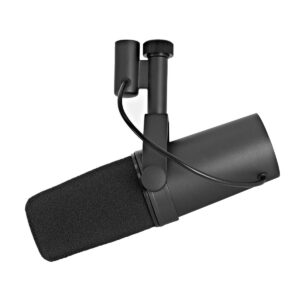 Specifications:
Specifications:
- Capsule: Dynamic
- Polar Pattern: Cardioid
- Frequency Response: 50 Hz – 20 kHz
Pros and Cons:
- Warm, smooth broadcast sound for podcasting, voiceover, and studio recording
- Low noise and room sound rejection for clean, quality audio
- Infamously quiet sound output when not boosted by external preamps
The Shure SM7B is an advancement of Shure’s dynamic vocal microphones that has been made for studios.
Its focused midrange and warm low-end deliver a modern take on the classic, sought-after “broadcast sound”. This makes it shine on all kinds of vocals, whether sung or spoken, and so it’s a mic of choice for not only musical recordings, but also podcasting, radio, and voiceover work.
As well as music legends such as Michael Jackson, Sheryl Crow, and Dave Grohl, the SM7B is also used by notable podcasters like Marc Maron, Anna Faris, and Dax Shepherd. Even professional voice actors and content creators like YouTubers and streamers will pick this versatile dynamic mic.
With the Shure SM7dB, you don’t need to worry about a quiet output from the microphone. This mic has a built-in preamp, meaning there’s no requirement for any inline preamps or high-end interfaces to get the most out of an SM7B.
The SM7dB has the same iconic sound as the SM7B but with the convenience of the built-in preamp, which is built on the “Cloud” technology that you would find in the iconic Cloudlifter preamp. The one in the SM7dB has been designed and optimised by Shure to give you the best sound possible.
8. SubZero P10 Pro
A versatile, vintage-inspired condenser mic for home recording
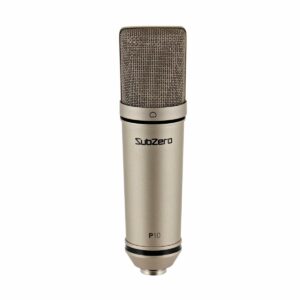 Specifications:
Specifications:
- Capsule: Condenser
- Polar Pattern: Cardioid
- Frequency Response: 20 Hz – 20 kHz
Pros and Cons:
- Vintage-inspired FET Condenser with warm sound
- Transformer balancing adds character and weight and prevents noise
- Vintage SPL handling means it’s not as well-suited to high-pressure sources
The SubZero P10 Pro is a large diaphragm condenser that boasts a full frequency response. A FET-based design with transformer circuitry to add a touch of character and reduce noise, the P10 Pro is designed to go toe-to-toe with vintage studio condenser mics.
The P10 Pro is very adaptable, making it great for musicians, content creators, and podcasters who like the sound of classic FET mics from the 1960s. This also makes it incredibly versatile for just about any instrument. Vocals, drums, guitars, and anything else you might need to capture will all shine with vintage warmth.
9. Lewitt LCT 240 PRO
An affordable and detailed condenser mic
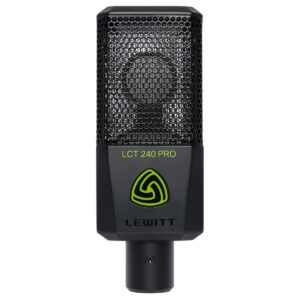 Specifications:
Specifications:
- Capsule: Condenser
- Polar Pattern: Cardioid
- Frequency Response: 20 Hz – 20 kHz
Pros and Cons:
- Affordable workhorse condenser mic with smooth, modern sound
- Full frequency response captures detail easily
- Exaggerated treble can cause some sources to sound more sibilant
The Lewitt LCT 240 PRO is a large-diaphragm condenser built to be an ideal first choice for home recording. Using Lewitt’s forward-thinking design philosophy and applying it to an inviting price bracket, the LCT 240 PRO is excellent on vocals, acoustic guitars, and anything that you might want to add high-end sparkle to.
The LCT 240’s excellent SPL handling also makes it well-suited as an affordable drum overhead mic in a pair or as a snare drum mic. Plus, it’s compact enough to fit on stage comfortably, making it a great pick for guitar amps and cabs or live acoustic guitars without getting in the way.
10. Austrian Audio OD303
Cutting-edge dynamic vocal mic
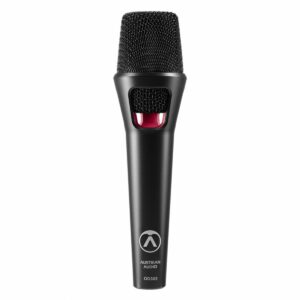 Specifications:
Specifications:
- Capsule: Dynamic
- Polar Pattern: Supercardioid
- Frequency Response: 35 Hz – 16 kHz
Pros and Cons:
- Supercardioid polar pattern provides tighter, more focused pickup
- Open Acoustics technology prevents the effects of mic cupping and keeps response consistent
- Proximity effect can cause low-end buildup with incorrect technique
The Austrian Audio OD303 is a modern and cutting-edge take on the live dynamic vocal microphone with a few twists. It boasts an open and even sound thanks to its broad frequency response, whilst its mechanical design and built-in pop filter prevent plosives, sibilance, and handling noise.
The OD303’s supercardioid polar pattern provides a tighter pickup pattern than many cardioid alternatives, providing a focused, tight sound that avoids feedback, even on packed stages. Austrian Audio have also included an innovative Open Acoustics system that keeps off-axis response consistent and prevents changes to its sound from obstructions or mic cupping.
11. Neumann TLM 102
Neumann’s take on an affordable, home-recording-ready condenser mic
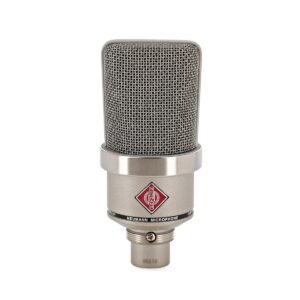 Specifications:
Specifications:
- Capsule: Condenser
- Polar Pattern: Cardioid
- Frequency Response: 20 Hz – 20 kHz
Pros and Cons:
- Detailed condenser mic with a rich, flat frequency response
- Transformerless circuitry prevents colouration and lowers self-noise
- No included shock mount or accessories
The Neumann TLM 102 is a large-diaphragm condenser microphone billed for home recording.
Whilst Neumann are veritable legends of studio recording – building quality studio mics since their inception in 1928 – they have always been a premium brand that sits out of reach for many home musicians and producers. Their TLM range aims to change this, with the TLM 102 taking inspiration from their renowned U87.
Whilst offering a different sound than the famed U87, the TLM 102 features a warm, smooth, uncoloured response that has the same home studio versatility that its predecessor does. Vocals, guitars, amps, bass, drums, and strings will all be accurately captured by this compact microphone.
What is an XLR microphone?
XLR microphones are microphones that use a common form of audio connector called XLR. This connector consists of three metal pins that help transfer the audio into a balanced electrical signal which will transfer itself via a balanced cable. XLR microphones offer lower noise and better audio quality that’s easier to correct in post-production than USB microphones, making them the choice for professional audio standards.
The best brands for XLR microphones
There are a lot of brands that produce exclusively XLR microphones or have recently branched out into also producing USB and hybrid microphones. However, for a quick guide, here are five of our top picks.
Shure
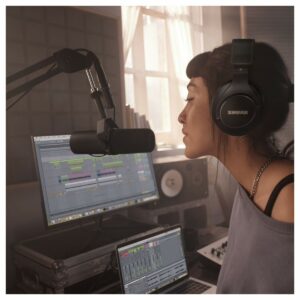 Shure are a leading microphone brand due to their robust and reliable designs. They are best known for their SM58, a popular live mic, and the SM7B, a popular vocal mic for studios.
Shure are a leading microphone brand due to their robust and reliable designs. They are best known for their SM58, a popular live mic, and the SM7B, a popular vocal mic for studios.
They make all kinds of microphones, XLR, USB, dynamic, condenser, and ribbon microphones, at all price points, from premium studio titans to affordable starter mics for budget-conscious home recording.
Neumann
Neumann have largely been a premium microphone brand. Founded in Germany in 1928, they pioneered condenser microphones and made the first commercially available one of its kind: the CMV 3. Throughout the 1950s and 1960s, other designs like the U47, U67, and U87 made the brand a household name.
Austrian Audio
Developed by former AKG engineers, Austrian Audio are a young brand that has a lot of collective experience backing them up. Since their founding in 2017, they have already released a comprehensive range of dynamic and condenser mics suitable for live and studio use, with cutting-edge designs that add something fresh to the market.
Their flagship OC818 is a unique dual condenser with multiple outputs, stereo capabilities, constantly adjustable polar pattern, and an utterly transparent sound.
Sennheiser
Sennheiser are a German brand that helped develop noise-compensating microphones for cleaner, clearer results than their competitors in 1945. Building a range of audio products, Sennheiser’s mics have always been smooth and detailed, with a range of condenser and dynamic mics on offer. Many are used in studios and for live performances.
Universal Audio
Universal Audio have primarily produced and pioneered other forms of audio equipment, like preamps, compressors, and even early recording and mixing consoles. However, they have expanded their output to high-end microphones in recent years, with the Sphere series becoming a popular and premium modelling microphone with a lot of flexibility and an excellent value proposition: 38 mics for the price of 1.
Keep an eye out for their Bock range, a set of premium studio microphones that refresh classic designs with a twist.
If you’d like more information on these brands and their history, check out our blog on the Top 16 Microphone Brands.
Types of XLR microphones
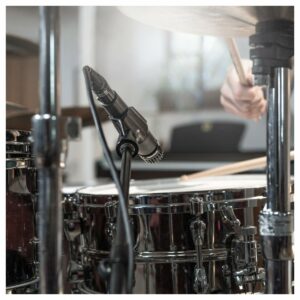 There are three main types of XLR microphones on the market: dynamic, condenser, and ribbon.
There are three main types of XLR microphones on the market: dynamic, condenser, and ribbon.
Dynamic microphones are the most simple. They utilise a moving coil of wire, called the voice coil, that’s pushed by a diaphragm through a magnetic field. Thanks to electromagnetic induction, this creates an electrical current which corresponds to the changes in air pressure from the sound that moved the diaphragm.
They are usually rugged, robust, and good as instrument mics and for live performance as they can handle higher sound pressures.
Condensers have a lighter, thinner diaphragm than dynamic microphones, with a fixed plate attached to it that acts as one half of a capacitor. The other plate is kept stationary.
The changes in distance between the plates change the strength of the electrical current over time to capture a sound. Condensers tend to have more detail thanks to the responsiveness of their thinner, lighter diaphragm with more sensitivity, making them popular in the studio.
They used to be used only on quieter sounds due to their delicate diaphragm, but modern designs can handle sound pressures on par with most dynamic mics today, allowing them to be used live or on loud drums and amps.
Ribbon microphones use a thin strip of aluminium between two magnets. As this ribbon of aluminium is moved by the sound, this induces a current.
Ribbons are an older design that got somewhat phased out by dynamic and condenser mics as this aluminium strip could easily break when subjected to loud noises. However, their warm sound still made them desirable on vocals and guitars, and new developments have made them tougher and more robust.
What about XLR cables?
XLR cables have three pins, with one positive, one negative, and one ground pin to prevent noise and electromagnetic interference. This is the primary benefit of XLR transmission overall since the output signal of the microphones and the cables themselves are both balanced.
Their design also offers superior audio fidelity, meaning that the sound is as true to the original source as the character and sound of the microphone can capture. This is sometimes enhanced by the frequency response of the microphone for an improved result.
You can’t go wrong with many XLR cables, but more expensive cables can be more durable, better isolated, or longer, so your pick for the price needs to balance all these elements.
The benefits of XLR connectors
XLR connectors are really reliable due to their easy latching system which locks the cable into place when you plug it in. So, there’s no sudden unplugging; your microphone, cable, and preamp or interface will stay in place during recording.
These connectors are so reliable that they’ve been completely unchanged since the mid-’50s.
Jargon buster
 Phantom Power: Phantom power is a method of boosting the signal of a microphone to audible levels, by adding a standard 48 volts to it. Most audio interfaces, preamps, mixers, and recording consoles have this feature, usually labelled “+48 V”.
Phantom Power: Phantom power is a method of boosting the signal of a microphone to audible levels, by adding a standard 48 volts to it. Most audio interfaces, preamps, mixers, and recording consoles have this feature, usually labelled “+48 V”.
Phantom power is absolutely necessary to operate condenser microphones. Be careful with what channels have phantom power applied to them as this can fry dynamic and ribbon microphones!
Grounding: Grounding is the term for a safety measure in electrical circuits, letting excess current exit the appliance safely. This avoids overloading and damaging either the microphone or the preamp it’s plugged into.
It also prevents the excess electricity from tampering with the audio signal or shocking the performers or engineers involved in the recording.
Omnidirectional, cardioid, supercardioid, figure eight: These terms are all polar patterns, which describe the pattern that microphones will pick up sound in.
Omnidirectional is an equal response all around the microphone, whilst cardioid picks up the front and rejects the sides and back. Supercardioid picks up in a tighter pattern in the front, rejecting even more of the sides and back. Figure eight picks up from both the front and back.
FAQs
Do XLR mics have better sound quality?
Yes, XLR microphones have better sound quality than USB microphones. Their sound fidelity is simply a higher quality with less noise than USB.
Why do XLR mics sound better?
XLR microphones sound better because their output is balanced, and XLR cables are balanced, resulting in a completely accurate, noiseless transfer of audio that is extremely accurate to the source signal. Alongside this better base fidelity, the design also lowers audible noise levels and prevents interference for a cleaner recording.
What is the best XLR mic for podcasting?
The Shure SM7B is the best microphone for podcasting due to its warm, smooth vocal sound. Thanks to its unique mounting system, it can comfortably fit on a microphone arm on a desk. Plus, its low-frequency cut and mid-presence boost EQ options help you make any voice sound clear and articulate.
Final thoughts
So, we’ve covered the benefits and features of XLR microphones, why XLR connectors are the standard for pro audio, the available types, and the kinds of things that these mics are good at. From home recording and studio workhorses to live performances on all kinds of stages, these picks of the best XLR microphones cover a range of applications. So, we hope you’ve found the right mic for you!

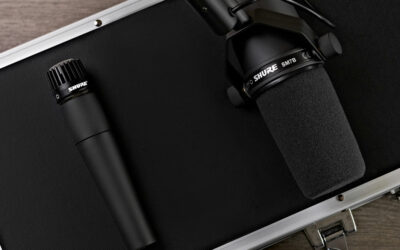
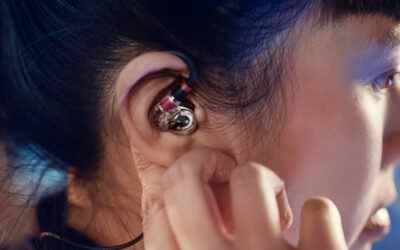
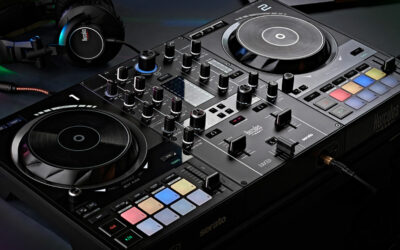

0 Comments